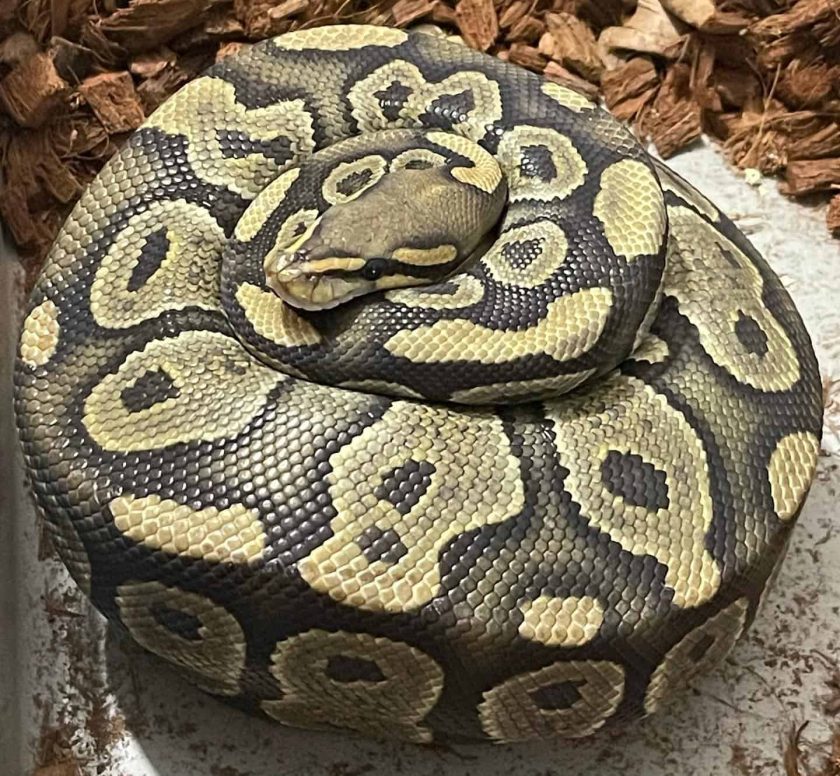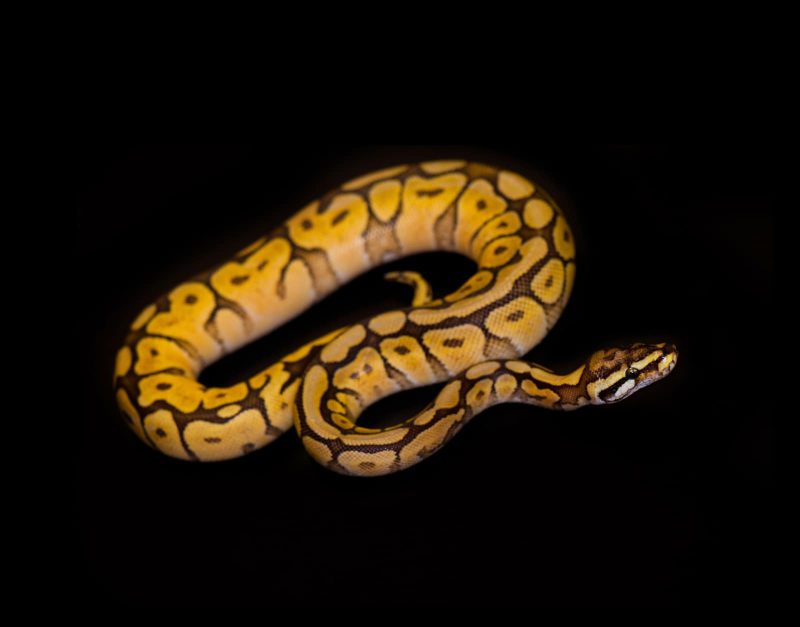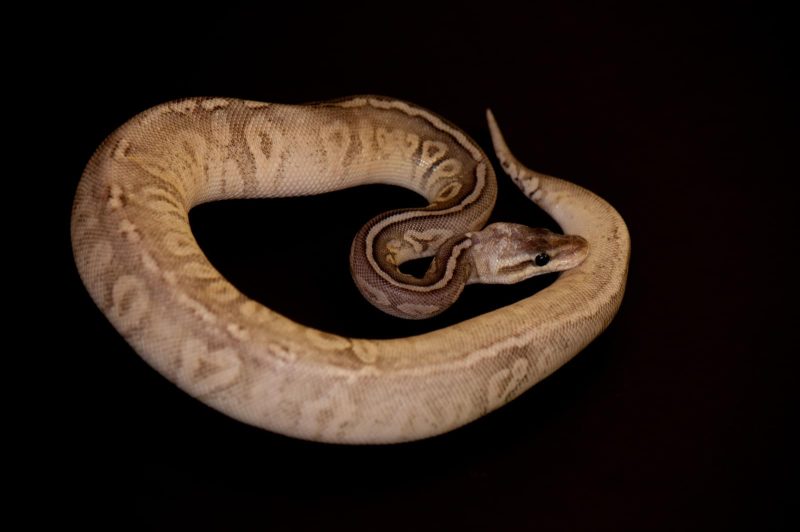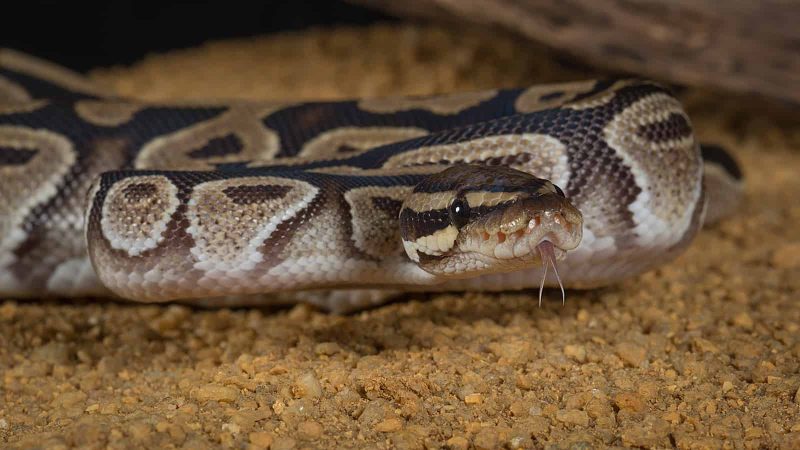I remember the day I went to buy my first ball python, like yesterday. It was an experience that opened up a whole new horizon of possibilities.
It all started when I decided to look into what kind of pet to get, and my eyes were soon captivated by the majestic ball python.
Its vibrant yellow scales, shining eyes, and long body were enough to spark a particular interest in me. Yet, at the same time, I wondered: would I be able to afford it?
To answer my question, I quickly began searching for the price of a ball python. After scouring through breeders’ websites, pet stores, and even online classifieds in my area, I discovered an expansive range of pythons with costs varying from as little as $20 to an astonishing $20,000.
This cost depends on several factors, including the age of the snake, its size, morph, and health condition. Some other costs are associated with caring for such an animal, like food supplies and proper housing.
Let’s dive deeper into the cost breakdown of Ball Python!
How Much Do You Have to Invest in a Ball Python?
When considering having a ball python as a pet, it’s important to remember that your total expense will include more than just the price tag. Depending on species and age, these reptiles can range anywhere from $20 – $10,000+; however, most fall between $100 -$500.
You shouldn’t forget to include ongoing expenses such as food, heating/lighting equipment, and an enclosure setup. These costs can range from $150 to $200 annually, so ensure you have enough funds set aside for them!
What Is the Cost of a Ball Python Itself?
The price tag on a ball python can be affected by factors such as age, size, and, most notably, its morph—the rare its physical characteristics are, the higher it will be priced. Therefore if you’re in search of an exclusive specimen, then you must be prepared to shell out extra cash.
| Morph | Cost |
|---|---|
| Spider Ball Python | $200-$500 |
| Albino Ball Python | $250- $700 |
| Axanthic Ball Python | $300-$600 |
| Banana Ball Python | $200-$700 |
| Mojave Ball Python | $100-$150 |
| Cinnamon Ball Python | $100-$300 |
| Bumblebee Ball Python | $120-$240 |
| Ghost Ball Python | $100-$175 |
| Blue, and Black-Eyed Lucys | $200-$2000 |
| Ivory Ball Python | $200-$400 |
| Leopard Ball Python | $100-$350 |
| Phantom Ball Python | $120-$240 |
| Mystic Ball Python | $150-$300 |
| Queen Bee Ball Python | $350-$650 |
| Pastel Ball Python | $120-$275 |
A regular ball python can cost you as little as $20. However, if you’re looking for something more unique – such as a specific morph and individual styling – the price range may exceed $200 and reach up to $10,000+ (the most expensive ball pythons).
On average, a ball python will cost anywhere from an affordable $50 to a hefty $500. However, you can expect to pay even more than that for some of the more searched-after morphs!
Here are some examples:
Classic Ball Pythons
With a bit of luck, you can find classic ball pythons from breeders at an unbeatable rate — usually between $40-80! And if reptile shows are your thing, there’s always the chance to get them for even less. After all, they aren’t in high demand.
Albino Ball Python
An albino ball python can cost you around between $250-350. However, if your snake has additional visual traits such as pied or super, it may cost around $600-700!
Spider Ball Python
You can get your hands on a stunning, one-of-a-kind pastel or spider python for an extremely reasonable price of $200. Even more extraordinary patterns and colors are accessible at just $500!
Piebald Ball Pythons
Piebald ball pythons manifesting the traditional colors cost between $300-700, while those incorporating three genes or distinct markings may sell for more than a thousand dollars. Adult piebald specimens that have developed to an age suitable for breeding tend to start at around $1200.
Axanthic Ball Python
Axanthic pythons with a less conspicuous look can be purchased for as little as $300. On the other hand, if you’re looking to show off something more dazzling or with multiple genes, such as pastel, these will cost at least $600 each.
Blue and Black-Eyed Lucys
Blue and Black-Eyed Lucys, or BELs for short, are characterized by their mesmerizing blue eyes and white scales. These creatures are particularly rare among morphs – yet due to their rarity, they tend to cost more than others at a hefty price of over $2K.
What is the Cost Of a Baby Ball Python?
Baby ball pythons are charming and provide exceptional value for your money! These attractive creatures come in various prices – from a low of $60 to an upper limit of roughly $200. The pricing depends on the morph and its availability.
What Are Ball Python Enclosure & Accessories Cost?
Ball pythons are unique pets that require an enclosure designed to replicate their natural habitat. However, maintaining this environment is cost-effective as most supplies only need to be purchased once! With minimal effort and expense, you can ensure your companion lives happily for years to come.
| Accessories | Cost |
| Terrarium/Enclosure | $70-$450 |
| Heating Apparatus | $10- $50 |
| Dry Hide | $10-$30 |
| Humid Hide | $10-$25 |
| Thermometer and Hygrometer | $10 |
| Thermostat | $25-$50 |
| Waste Remover | $12-$15 |
| Water Bowl | $10-$20 |
| Light Fixtures | $10-$30 |
| Decorations | $100 |
| Shower or Spray Bottle | $10-$20 |
| Total | $250-$800 |
Terrarium/Enclosure Cost
The cost of the enclosure can vary depending on the size of the terrarium. The ‘right’ tank size for your ball python is quite controversial. An adult requires a minimum of 20-gallon enclosure, although giving them something larger is suggested.
One with 40 gallons would be ideal as there will be sufficient room for an adult snake and enough space to incorporate different hides and vegetation, so the habitat stays varied.
Depending on the size of the tank that you get, you can expect to pay anywhere as
- 20-gallon tank – $70-200
- 40-gallon tank – $150-240
- 67-gallon tank – $300-450
Dry Hide Cost
Ball pythons require hides to feel secure and comfortable in their habitat. Typically, it is recommended that you should have two dry hideouts:
- One on the warm side of the tank.
- One on the cold side of the tank.
It gives them a choice of where they would like to relax, and It will cost you only $10-30 to outfit your ball python with an appropriate dry hide.
Humid Hide Cost
A humid hide offers a cozy atmosphere for your python, as it closely resembles dry hide, with the primary distinction being that humidity levels are kept higher. This moisture can make shedding easier and ensure your reptile stays comfy!
You can either make your humid hide at home or buy one. Tupperware filled with moss is a great inexpensive choice that won’t cost you more than $10! However, there are even better options, like specially designed hides ranging from roughly $20-25.
Heating Apparatus Cost
Ball pythons are ectothermic or cold-blooded animals, meaning they can’t generate heat. To ensure your scaly friend lives comfortably in its tank, you must provide the right amount of heat. You can achieve this optimal temperature by one of the following methods.
- An under-tank heating pad can range between $20 and a maximum of $50.
- A heat lamp or Dome can range from just $10 to $35.
Thermometer and Hygrometer Cost
Monitoring the temperature and humidity levels in your ball python terrarium is essential, so you’ll need to invest in a thermometer and hygrometer. Fortunately, these items are quite affordable – costing less than $10.
Thermostat Cost
Investing in temperature-controlling devices is a small price for peace of mind, costing you only $25-$50. These tools guarantee that your heat lamps and pads will not exceed their optimal temperatures within the ball python enclosure, creating a safe environment.
Scoop Cost
You should regularly dispose of urine and fecal matter for peak cleanliness of your ball python’s terrarium – fortunately, a waste remover can help with that task at an affordable rate of $12-15.
Water Bowl Cost
We highly recommend investing in something durable – any slight push or impact can cause it to tip over if it’s too lightweight. You won’t have to break the bank either because a decent bowl of this caliber should only cost around $10-20.
Light Fixtures Cost
Installing a light fixture in your snake’s tank is an optional accessory, although many believe it is necessary for their pet snakes. But this isn’t the case – in fact, continuous exposure to light can disturb your snake’s sleep cycle and cause distress. Nevertheless, high-quality lighting fixtures can be acquired for a reasonable $10-$30.
Decorations Cost
Transform your ball python’s tank into an oasis with rocks, sticks, plants, and hideaways. You’ll find that these accessories provide the ideal environment for a happy and healthy snake.
You can easily create a stunning environment for under $100 with imagination and the right items. However, if you’re looking for more authentic accessories such as intricate hides or remarkable fake plants, make up your mind to spend above that figure.
Shower or Spray Bottle Cost
Ball pythons thrive in environments with moderately high humidity. Keeping their enclosure adequately misted is always a good idea to ensure your pet’s well-being.
For this task, you will need an affordable spray bottle that can produce fine mists–these typically range from $10-20 dollars and are worth the investment!
What Do Ball Python Consumables Cost?
As an owner of a ball python, it is important to know that the primary cost each year will most likely revolve around consumable products. These include food, substrate, and moss, which all must regularly be used or replaced.
| Consumables | Cost |
| Food | $1-$3 per meal |
| Substrate | $50-$70 per annum |
| Sphagnum moss | $20 per annum |
Food Cost
Ball pythons are carnivorous creatures that feast only on meat, primarily rodents. The cost of the rodent you feed your python depends on its size; additionally, the size and age of your snake will dictate what type and how many rodents it requires for a healthy diet. For example:
- Small juveniles – For optimal growth and development, small juveniles should feed on the small pinkie mice, costing around $1-2 per mouse.
- Adults – Larger mice can provide the ideal nutrition for adult pythons. These larger mice will cost you around $4-5 per mouse.
- Larger Ball Pythons – The diet for large ball pythons may include large rats, which can be expensive at up to $10-15 per rat.
Overall, a ball python’s annual food expenses are quite reasonable – ranging from an average of $130 – $350. This is far less than the upkeep required for most other pets!
Substrate Cost
Substrates can range from free (like a newspaper) to quite expensive ($5-$10 per bag of Aspen shavings at your local pet store). No matter the cost, it is important to ensure you purchase the right substrate. Investing just $50-$70 each year to replace your substrate every two months will ensure that you always have a high-quality tank bed.
Sphagnum Moss Cost
The sphagnum moss that is proven to maintain moisture longer only needs to be replaced when it appears to wear out. Despite its occasional need for replenishment, this moss will only add a minimal expense — close to $20 per year —to your overall ownership costs.
How Much Does Ball Python Medical Care Cost?
Regardless of how much love and care we lavish on our scaly friends, ball pythons are living creatures susceptible to medical problems.
Even if we do everything possible to create a safe, healthy environment for them, they may still experience the following unexpected issues, which will inevitably add costs to their regular maintenance.
- Parasitic infestation
- Viral diseases of snakes
- Mouth rot
- Pneumonia
- Retained eye caps
- Ascariasis
- Many others
An initial vet visit may cost up to $100, while treatments afterward will vary from an affordable price of five dollars up to hundreds of dollars depending on severity. Taking just a few moments out of your day to nip the issue in the bud could save you costly billings in the long run!
Are Ball Pythons Cheap Pets To Own?
Ball pythons make for a great and cost-effective pet, especially compared to other reptiles or animals. The following are just some of the reasons why they’re such an accessible choice:
- They require a fairly minimal set-up and can live comfortably in small enclosures.
- Food is also relatively inexpensive, as most adults only need to be fed once every week or two.
- The initial cost for supplies such as the terrarium, bedding, heat mat, and thermometer can seem high, but they often last for many years with proper care.
- In addition, ball pythons are very low-maintenance pets that don’t require regular grooming like some other pets.
Overall, they are an excellent choice for people looking for a wallet-friendly pet snake!
Final Thoughts
Ball pythons are perfect for pet owners who don’t have the time or energy to care for a dog or cat and want to save money in the long run. Compared to these traditional pets, ball pythons require considerably less attention and fewer meals, making them incredibly affordable and simple to maintain with minimal oversight – so you can enjoy all of the perks of having an exotic pet without breaking the bank!
Featured Image by Constricted Reptiles






2 Comments
Aspen shavings are not suitable for snakes requiring high levels of humidity, such as ball pythons. I’ve seen too many people with dehydrated ball pythons because they use aspen shavings without knowing any better. My blood pythons prior home had aspen shavings, and after three perfect sheds in her new home, her dented eye caps from dehydration have finally been fixed. Repti bark, cypress mulch, Forest Floor, or even better, a mixture of organic topsoil and playsand in a 70/30 combo that can be purchased from your local hardware store for a fraction of the cost of any reptile branded substrates.
Hello Colin,
You’re absolutely right! Different snakes require different levels of humidity, and their substrate should reflect this. Aspen shavings, while perfect for some reptiles, can indeed be too dry for Ball Pythons and Blood Pythons that thrive in higher humidity environments.
The alternatives you’ve listed – Repti bark, cypress mulch, Forest Floor, and organic topsoil/playsand mix – are great options that better retain moisture. They can create a more suitable environment for these species and help avoid problems like dehydration and shedding issues.
Thank you for sharing this important advice. It’s crucial for all pet owners to thoroughly research their pets’ specific needs.